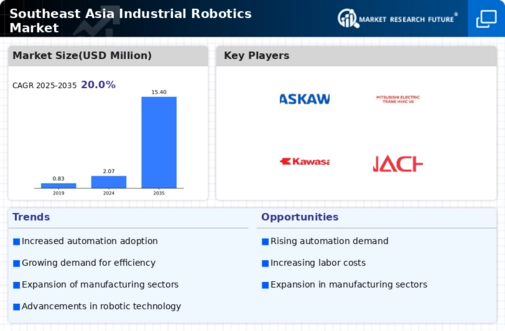-
Growing adoption of Industry 4.0 and the adoption of robots in the manufacturing sector are driving the market growth
The advent of Industry 4.0 has spurred the emergence of novel technologies like AI-enabled robots and collaborative robots, enabling industries to optimize processes, enhance productivity, and minimize errors, which is driving the market CAGR. A 2019 forecast by CSIRO suggested that effective digital transformation could potentially boost Vietnam's GDP by an additional $162 billion over 20 years. Industrial robots, considered advanced digitalization tools, are primarily utilized for automation within the manufacturing sector. Thailand has witnessed a rapid increase in the operational stock of robots in manufacturing, rising from approximately 1,500 robots in 2008 to over 21,000 robots in 2018.
Despite this growth, Thailand's robot density in 2019 stood at 60 per 10,000 employees, notably lower than the global average of 113. Robotics usage in Thailand is mainly concentrated in the automotive industry, accounting for 50% of all industrial robots in 2019, with an additional 30% in the electrical and electronics sectors.
In July 2023, an article titled "UN Uses AI-Enabled Robots to Monitor Climate Change" highlighted the UN's utilization of AI-enabled robots to monitor and address climate change impacts. These robots improve data collection accuracy, efficiency, and safety in remote areas, enabling real-time monitoring and effective mitigation strategies. While promising to address climate change challenges, further research and development are deemed necessary. The increasing adoption of Industry 4.0 in manufacturing worldwide serves as a major catalyst driving the growth of robotics across various industries, thereby propelling market expansion. Thus, driving the Southeast Asia Industrial Robotics market revenue.
SEA Industrial Robotics Market Segment Insights:
SEA Industrial Robotics Type Insights
The Southeast Asia Industrial Robotics market segmentation, based on type, includes Traditional Robots (Articulated Robots, Cartesian Robots, SCARA Robots, Parallel Robots, Cylindrical Robots, and Others) and Collaborative Robots. The collaborative robots segment dominated the market. The collaborative type has secured the largest market share, primarily because these robots are engineered to work alongside humans in a shared workspace. They find application in a diverse array of tasks such as packaging, pick-and-place, screw driving, assembly, lab testing, and quality inspection, owing to their ability to swiftly automate tasks.
Moreover, collaborative robots can often be taught by operators instead of requiring complex programming. Furthermore, their capacity to perform repetitive tasks quickly not only enhances manufacturing productivity but also contributes to workplace safety improvements. Given their numerous advantages and wide-ranging applications, the demand for collaborative robots continues to surge across various industrial sectors, including retail, healthcare, and automotive manufacturing. These factors collectively contribute to the growth of this segment.
SEA Industrial Robotics Payload Insights
The Southeast Asia Industrial Robotics market segmentation, based on Payload, includes Up to 16.00 kg, 16.01-60.00 kg, 60.01-225.00 kg, and more than 225.00 kg. The 16.01-60.00 kg category generated the most income. Robots in this category include collaborative, SCARA, and articulated robots. Those with a payload capacity ranging from 16.01 to 60.00 kg are predominantly utilized in the automotive sector, particularly for tasks like arc welding, spot welding, painting, and more. The electrical and electronics industry is experiencing a significant surge in automation demand, particularly in the utilization of SCARA robots for assembly and handling applications.
This trend is fueling the rapid growth of the segment within the 16.01 to 60.00 kg weight range. SCARA robots are favored for their higher operating speeds and optional cleanroom compatibility.
Figure 1: Southeast Asia Industrial Robotics Market, by Payload, 2023 & 2032 (USD Billion)
The Southeast Asia Industrial Robotics Market is poised for transformative growth, driven by increasing automation across various sectors, which appears to enhance productivity and efficiency in manufacturing processes.
Ministry of Trade and Industry, Singapore





